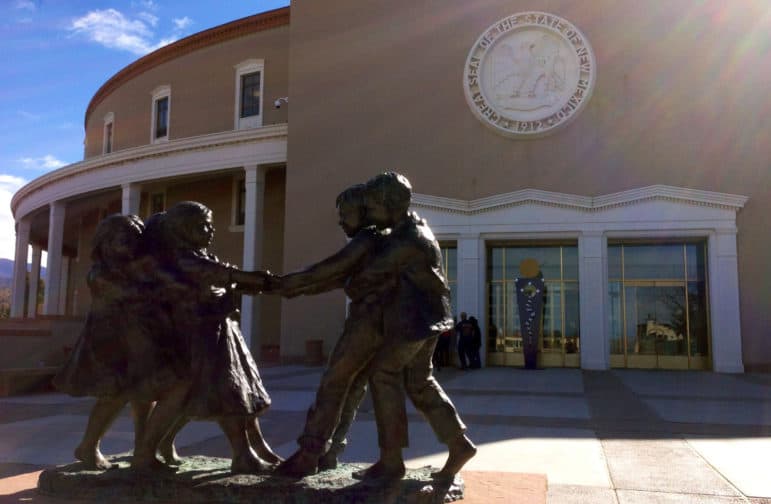
Heath Haussamen / NMPolitics.net
A statue outside the Roundhouse in Santa Fe.
Efforts to cap the number of charter schools that could open in the state have failed for years, primarily because lawmakers from both parties did not have the appetite to support such bills and because former Gov. Susana Martinez was pro-charter.
This year is shaping up differently. Members of the Senate and the House of Representatives are looking at a new way to keep charter schools from increasing.
Lawmakers in each chamber have introduced sweeping reform bills that would, among other measures, limit statewide charter school enrollment to 27,000 students.
That wouldn’t leave much room to grow. About 26,000 students are enrolled in the 97 charter schools in New Mexico. They make up about 7 percent of the state’s 330,000 students in public schools.
The measures to limit charter enrollment are House Bill 5 and Senate Bill 1. Most of the bill sponsors are Democrats, but Sen. Gay Kernan, R-Hobbs, has joined with them.
Charters are public schools, but they are overseen by an independent board and have more freedom and flexibility with their programming.
Leaders of Santa Fe charter schools say they don’t understand the reasoning behind the cap and think it cuts options for students and parents.
“For the most part, I don’t think people would go to charter schools unless they weren’t getting what they want someplace else,” said Anne Salzmann, head of The Masters Program dual-credit charter school in Santa Fe, which has about 215 students in grades 10 through 12.
Susan Lumley, principal of the Academy for Technology Charter School, said parents are the reason charter schools exist.
“They want something a little different,” she said.
But Rep. Christine Trujillo, a Democrat from Albuquerque and one of the sponsors of the House bill, said data show that charter schools are funded at a disproportionately high rate compared to traditional public schools.
For example, a recent New Mexico Legislative Finance Committee report stated that funding formula changes benefited charter schools by $122.3 million between 2008 and 2018. Traditional public schools only received $107.2 million due of those changes.
That’s because the law allows charter schools to take advantage of the state’s small-school funding formula. It’s designed to give rural school districts adequate money to operate, but the law also allows charter schools to launch programs with funding that doesn’t require legislative approval.
“What ends up happening now is that the charter schools get a lot of extra funding beyond what goes to traditional schools and it becomes very imbalanced,” Trujillo said.
The House and Senate bills call for a change in the small-school funding formula. Traditional and charter public schools in a school district with more than 2,000 students would see a phase-out of that extra funding within three years. Santa Fe Public Schools’ enrollment hovers around 13,000, so those changes might apply to charters in town.
Lumley said her school usually gets an extra $200,000 for operational expenses through the funding formula. With an annual budget of about $2.7 million, the school might survive that decrease but the revised formula “is going to put some charter schools out of business,” she said.
Trujillo said she is not against charter schools but believes they require more oversight. Two years ago she introduced a bill cap on opening new charters until the state could review their academic performance and financial reports.
The Legislature rejected that bill, but Trujillo said she plans to introduce similar legislation during this year’s 60-day session currently underway.
Gov. Michelle Lujan Grisham, a Democrat, has publicly said she would like to halt the opening of more charter schools.
Last week Matt Pahl, executive director of Public Charter Schools of New Mexico, said the state’s parents and students would be hurt by such a moratorium.
The state and individual school districts can authorize new charter schools. The state has already approved two new charters for next year, and two to four applications might be pending on the district level around the state, a spokeswoman for the Public Education Department said last week.